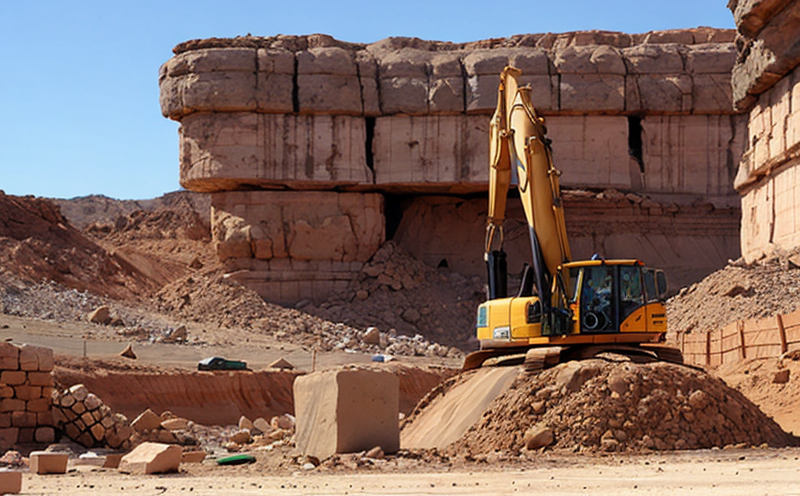DIN 22036 Rock Salt Creep Testing
The DIN 22036 standard provides a comprehensive framework for creep testing on rock salt materials. This test is critical in ensuring the integrity and safety of structures that are subjected to long-term mechanical stress, particularly those built into or near rock salt deposits.
Rock salt, also known as halite (NaCl), is widely used in various applications including road de-icing, industrial processes, and food preservation. Given its extensive use, it's essential to understand the behavior of rock salt under mechanical stress over time. The creep testing procedure specified by DIN 22036 helps engineers evaluate the long-term deformation properties of these materials.
The test involves placing a specimen of rock salt in a controlled environment where it is subjected to constant tensile or compressive loads. This allows for the measurement of how much the material deforms over time under these conditions. Creep testing is particularly important when assessing structures such as mines, tunnels, and underground facilities that are at risk of mechanical failure due to prolonged stress.
The DIN 22036 standard specifies detailed procedures for conducting this test, including specimen preparation, loading protocols, and measurement techniques. Specimens must be carefully prepared to ensure they represent the material accurately. This typically involves cutting the rock salt into cylindrical or prismatic shapes of specific dimensions as outlined in the standard.
The testing apparatus used for DIN 22036 creep testing includes a loading frame capable of applying uniform stress over an extended period. Strain gauges are attached to the specimen to measure its deformation accurately. Temperature control is also essential, as it can significantly influence the test results.
One of the critical aspects of this testing procedure is ensuring that all measurements are consistent and repeatable. This is achieved by adhering strictly to the guidelines provided in DIN 22036. The standard specifies precise procedures for specimen preparation, loading rates, and temperature control to minimize variability.
The results of creep tests conducted according to DIN 22036 are used to predict the long-term behavior of rock salt under stress. This information is invaluable for engineers designing structures that will interact with or be built into these materials. For instance, in mining operations, understanding the creep properties helps in planning safer and more efficient extraction processes.
Moreover, compliance with DIN 22036 ensures that tests are conducted to international standards, providing a level of reliability and consistency that is crucial for quality assurance purposes. This standardization also facilitates collaboration between different stakeholders involved in the design and construction phases of projects involving rock salt materials.
International Acceptance and Recognition
- DIN 22036 creep testing procedures are widely recognized in Europe, particularly within the mining and geotechnical sectors. Many international organizations, including the European Committee for Standardization (CEN), have adopted this standard.
- The results of DIN 22036 tests are accepted by regulatory bodies across multiple countries, including Germany, Austria, Switzerland, and parts of Eastern Europe. This acceptance enhances the credibility of testing conducted according to these standards globally.
Benefits
The implementation of DIN 22036 creep testing offers numerous benefits for stakeholders in the mining and geotechnical sectors. Firstly, it provides a reliable method to assess the long-term mechanical stability of rock salt materials. This ensures that structures designed with or into these materials are safe and durable over extended periods.
Secondly, compliance with this standard enhances quality management by ensuring consistent and repeatable test results. This is particularly important in regulatory environments where conformity assessment is required. By adhering to DIN 22036, companies can demonstrate their commitment to high-quality practices and meet the expectations of customers and regulators.
Thirdly, the use of this standard facilitates better decision-making during the design and construction phases of mining projects. Engineers and procurement officers benefit from a deeper understanding of material behavior under stress, leading to more informed choices about structural integrity and longevity.
The standard also supports research and development efforts by providing a standardized framework for testing. This allows for more accurate comparisons between different materials or variations in processing techniques, contributing to innovation within the sector.
Competitive Advantage and Market Impact
Implementing DIN 22036 creep testing can provide significant competitive advantages. By ensuring that products meet international standards, companies can gain a reputation for quality and reliability. This is particularly important in the mining industry where trust among stakeholders is paramount.
The ability to conduct consistent, reliable tests according to this standard also opens up opportunities for international collaboration. Companies can work with global partners who recognize DIN 22036, expanding their market reach and potential client base.
In the context of compliance, meeting these standards is essential for maintaining certifications and regulatory approvals. This not only helps in avoiding costly non-compliance penalties but also enhances customer confidence, which can lead to increased sales and market share.
Moreover, the insights gained from DIN 22036 testing can drive improvements in product design and manufacturing processes. By identifying potential weaknesses early on, companies can implement corrective measures, further enhancing their competitive position.





